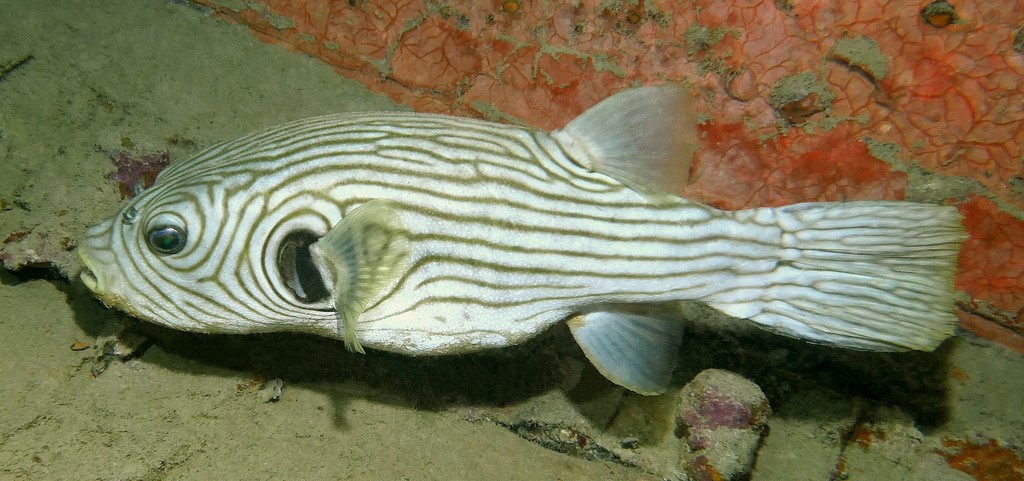AROTHRON RETICULARIS - (BLOCH & SCHNEIDER, 1801)
Picture courtesy of: Gloup Noumea
Actinopterygii (Gigaclass) > Actinopteri (Class) > Teleostei (Subclass) > Tetraodontiformes (Order) > Tetraodontoidei (Suborder) > Tetraodontidae (Family) > Arothron (Genus)
Reticulate toadfish, Lined toado, Reticulated toadfish, Reticulated pufferfish, Reticulated puffer, Wamonfugu, ワモンフグ, 網紋叉鼻魨,
Synonymes
Tetraodon reticularis (Bloch & Schneider, 1801)
Tetrodon reticularis (Bloch & Schneider, 1801)
Tetrodon reticularis (Bloch & Schneider, 1801)
Tetrodon testudinarius (Müller, 1841)
------------------------
Description
Dorsal soft rays (total): 9-11 (usually: 10); Anal soft rays: 9-10 (usually: 10); Pectoral fin rays: 16-19. Head and body with spinules except around mouth and posterior caudal peduncle, best developed spinules on ventral surface; Nasal organ with two bifid fleshy flaps; Short snout, length about: 2.0-2.3 in Head Length; Rounded caudal fin, length: 4.0-5.0 in SL. Max. length: 65.0 cm TL. Depth range: 1 - 53 m, usually: 1 - 25 m.
Color
Greenish-brown body many white lines, spots and reticulations above, white lines around the eye and gill opening, and lower sides ans belly white with greenish-brown lines curving upwards on sides of head; Pectoral fin base black, often with pale lines, and white pigment surrounding the anus. Fins greenish-brown, caudal fin with pale spots.
Etymology
Arothron: from Greek prefix, a- = without + from Greek, rhothon = noze, nostril. Referring to two finger-like nasal tentacles instead of nasal pores.
reticularis: from Latin, reticulum (small net). Referring to many brown reticulations (along with lines and spots) on upper body.
Original description: Tetrodon reticularis Bloch & Schneider, 1801 - Type locality: Malabar sea, India.
Distribution
Indo-West Pacific: India and Bangladesh, east to Philippines and New Guinea, north to central Japan, south to northern Australia and New Caledonia.
Description
Dorsal soft rays (total): 9-11 (usually: 10); Anal soft rays: 9-10 (usually: 10); Pectoral fin rays: 16-19. Head and body with spinules except around mouth and posterior caudal peduncle, best developed spinules on ventral surface; Nasal organ with two bifid fleshy flaps; Short snout, length about: 2.0-2.3 in Head Length; Rounded caudal fin, length: 4.0-5.0 in SL. Max. length: 65.0 cm TL. Depth range: 1 - 53 m, usually: 1 - 25 m.
Color
Greenish-brown body many white lines, spots and reticulations above, white lines around the eye and gill opening, and lower sides ans belly white with greenish-brown lines curving upwards on sides of head; Pectoral fin base black, often with pale lines, and white pigment surrounding the anus. Fins greenish-brown, caudal fin with pale spots.
Etymology
Arothron: from Greek prefix, a- = without + from Greek, rhothon = noze, nostril. Referring to two finger-like nasal tentacles instead of nasal pores.
reticularis: from Latin, reticulum (small net). Referring to many brown reticulations (along with lines and spots) on upper body.
Original description: Tetrodon reticularis Bloch & Schneider, 1801 - Type locality: Malabar sea, India.
Distribution
Indo-West Pacific: India and Bangladesh, east to Philippines and New Guinea, north to central Japan, south to northern Australia and New Caledonia.
Biology
Occurs in shallow water reefs near sand or seaweed areas. Also found in estuaries and protected muddy bays; Juveniles in mangroves and entering the lower reaches of streams. Solitary. Adults at moderate depths, often laying on the mud during the day. Oviparous.
Similar species
Arothron hispidus (Linnaeus, 1758) - Reported from New Caledonia - Link to the species (here). Differs from Arothron hispidus in having curved pale and dark lines or bands on the snout, cheek and belly rather than white spots.
Occurs in shallow water reefs near sand or seaweed areas. Also found in estuaries and protected muddy bays; Juveniles in mangroves and entering the lower reaches of streams. Solitary. Adults at moderate depths, often laying on the mud during the day. Oviparous.
Similar species
Arothron hispidus (Linnaeus, 1758) - Reported from New Caledonia - Link to the species (here). Differs from Arothron hispidus in having curved pale and dark lines or bands on the snout, cheek and belly rather than white spots.
Arothron manilensis (Marion de Procé, 1822) - Reported from New Caledonia - Link to the species (here). Large adults of Arothron reticularis have lines on the body that are similar to those of Arothron hispidus.
Last update: 1, May 2024
